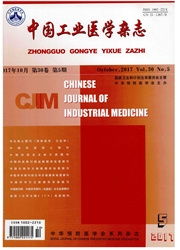

 中文摘要:
中文摘要:
目的观察姜黄素干预对无机砷暴露所致急性肝脏损伤的拮抗作用。方法实验小鼠自由饮用不同浓度(10 mg/L、50 mg/L和100 mg/L)亚砷酸钠(NaAsO2)6周,再分别给予姜黄素灌胃干预(200 mg/kg和600 mg/kg,每周2次),分别测定小鼠血清ALT和AST活力,全血和肝脏GSH含量以及肝脏MDA含量。结果与单纯染毒组小鼠相比,姜黄素干预组血清ALT和AST活力显著下降,全血和肝脏GSH含量显著升高,且肝脏MDA含量显著降低,差异具有统计学意义(P〈0.01)。结论姜黄素干预对无机砷暴露小鼠的急性肝脏毒性和氧化损伤具有一定的拮抗作用。
 英文摘要:
英文摘要:
Objective Survey the antagonistic effect of curcumin on inorganic arsenic-induced acute liver injuries. Methods Sixty Kunming female mice were divided into 10 groups, 9 groups were exposed different doses of arsenic ( 10 mg/L, 50 mg/L and 100 mg/L NaAsO2) contained water by drinking freely for 6 weeks, one group only given water. Different dosages of curcumin (200 mg/kg and 600 mg/kg) were given by gastric perfusion twice a week, then determine the activities of serum ALT and AST, MDA content of liver, GSH content in whole blood and liver, and liver GSH-Px activity. Results Compared with arsenic exposure groups, the risen serum ALT and AST activities of curcumin groups showed significantly decreased (P 〈 0.01 ), the liver content of MDA was significantly reduced ( P 〈 0. 01 ), while the whole blood GSH and liver GSH contents were significantly elevated (P 〈 0. 01 ). Conclusion The results suggested that curcumin has a certain some antagonistic effect on oxidative damage of liver induced by arsenic in mice.
 同期刊论文项目
同期刊论文项目
 同项目期刊论文
同项目期刊论文
 Sodium arsenite induced reactive oxygen species generation, nuclear factor (erythroid-2 related) fac
Sodium arsenite induced reactive oxygen species generation, nuclear factor (erythroid-2 related) fac Activation of the Nrf2 Pathway by Inorganic Arsenic in Human Hepatocytes and the Role of Transcripti
Activation of the Nrf2 Pathway by Inorganic Arsenic in Human Hepatocytes and the Role of Transcripti Tert-Butylhydroquinone as a Phenolic Activator of Nrf2 Antagonizes Arsenic-Induced Oxidative Cytotox
Tert-Butylhydroquinone as a Phenolic Activator of Nrf2 Antagonizes Arsenic-Induced Oxidative Cytotox Hepatic and Nephric NRF2 Pathway Up-Regulation, an Early Antioxidant Response, in Acute Arsenic-Expo
Hepatic and Nephric NRF2 Pathway Up-Regulation, an Early Antioxidant Response, in Acute Arsenic-Expo 期刊信息
期刊信息
